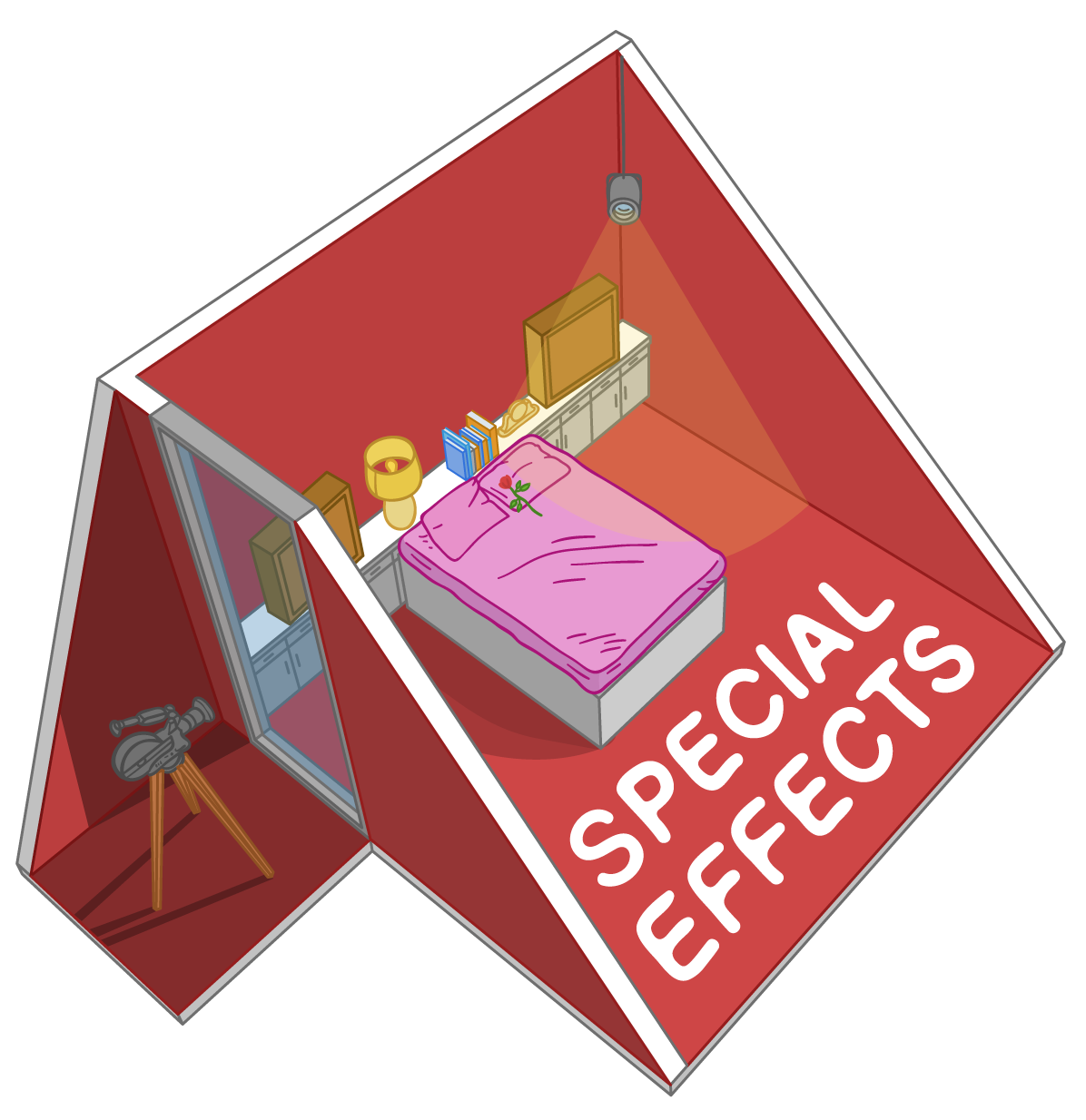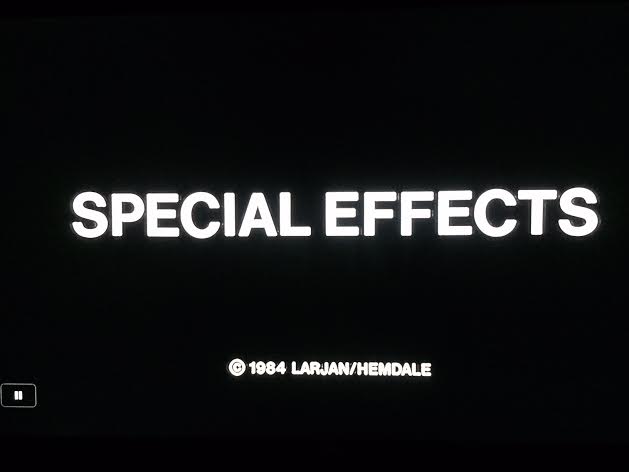October Diaries: Special Effects
 Â
Illustration by Max Brown
Blurbs by Shannon Neale, Sean & Christof
Â
Illustration by Max Brown
Blurbs by Shannon Neale, Sean & Christof—
October 4th, 2015:
Special Effects
Year: 1984
Director: Larry Cohen
Format: DVD
From IMDB: A director makes a movie based on a murder he committed.
Taglines:Â Andrea was dying to get in the movies …
Shannon Neale’s Take:
What I liked:
Aesthetic links to the Kuchar brothers! Between pink SATIN SHEETS and RED ROSES, a movie about movie making, and extremely bright set design, I felt cheekily knowing that Larry Cohen must have peeped Mike and George Kuchar’s films while living in the Bronx.
The scene where Mary Jean/Andrea first arrives at Chris Neville’s apartment is especially lavish and visually pleasing. Plants adorning walls and balconies, mirrored hallways, cool optical curtains, tropical, expressive birds, a swimming pool that Andrea acknowledges in a strictly profilmic manner, by kneeling down and splashing the water with her hands a little (so stupid, loved that moment). Most anything that occurred in Neville’s house felt like what the Kuchars might’ve done with a big fat budgie (budget).
Some flourishes (like a two second shot of a fire breather) nicely round out the otherwise narrow, serpentine plot.
I liked the introduction of Elaine’s character. She had her glasses tucked over her hair, which is always a winning look. She said something to the effect of, “And on Thursdays I’m busy with feminist stuff.” Elaine was apparently the same actress as Andrea/Mary Jean/whatever the f her name is now, and she got to show off her range.
What I didn’t like:
Lots of suspenseful music throughout the whole movie with very little suspense to accompany it. Just a humming, anticipatory synth note held throughout. Don’t like being told how to feel (via the music) when I’ve been lead to feel otherwise (via the unlikable protagonists).
Vapid, inexplicable characters. Felt nothing toward the husband character. Felt annoyed when the detective’s resolve dissolved and he became an adviser on Neville’s picture.
Bad hair, especially Eric Bogosian’s, which was actually his own. Something about his look made him even less likable for me than he was already supposed to be. Maybe this was exactly the look they were going for. There’s something about his face, those wide eyes, surrounded by a halo of tight black curls… Yeesh.
Final Thoughts:
There was bad make up, apparent wig wearing, overacting, and delightfully varied colors/fabrics/sets. I appreciated these elements, but mostly just tolerated the rest of it.
Christof’s Take:
What I Liked:
How I felt by the end of the movie as opposed to how I felt at the beginning of the movie.
I did like the title’s incorporation into the motives of Neville. He has footage of killing a woman, and then he wishes to tell her story, so he must cast a look-alike in order to include his private footage into the movie. He says that special effects are making an audience believe something fake is real, but the reverse is also true. Making an audience believe something real is actually fake is another kind special effect.
As the ludicrous plot unfolded, I could see more and more of a critique about the film industry and its sleazy treatment of women. At one point, the villainous film director and bona fide creepo, Chris Neville, hands over a contract to his leading lady, Elaine, and says, “Don’t read it. Sign it.†She literally looks away as she signs it. Then Neville says, “Now you’re in the movies.†Before casting her, he also commented that her eyes need to be “dumberâ€. While Elaine is not an ideal representation of women in film (this is spite of her character being busy with her “feminist things†on the weekend), she does seem to at least be symbolic of an intelligent woman being manipulated, exploited, and reduced.
The best bits were weird flourishes that stood out as very Larry Cohen. The instance that comes to mind is the character of Neville trying to be charming by delivering a boisterous monologue that is him pretending he’s in a commercial for “Mario’s Kitchenâ€, and he delivers this at an indecent volume after being seated in a fancy restaurant. It goes on for an awkward and wonderful length of time.
What I Didn’t Like:
I did not like the beginning. I may like it more in retrospect, but I wasn’t reacting well to the editing and logic of the beginning. The movie felt like it was still waking up from a long nap. It had a sleepy sensibility that I wasn’t really down with.
Also, there is some horrid (if somewhat amusing) ADR work on  I was worried might be the lead, since no one else’s voices had been swapped but her’s. The actor, Zoë Lund, would return, but her initial character would not. And when she returned, her voice was still weird, but it was certainly hers.
Final Thoughts:
I have a theory. And I do not have any idea how much of this is based on trying to rationalize this movie to myself as a better film. However, it wouldn’t surprise me if Larry Cohen had purposefully made a film that gets better as you watch it. The performances, the cinematography, the editing, as well as the writing — all of it seemed to have improved by the end. With this kind of concept, techniques like bad ADR could be the actual special effects to which the title refers. But that’s a hopeful stretch at best.
With themes of obsession and molding one woman into another, it seemed to be Larry Cohen’s Vertigo. With the emphasis on “Larry Cohen’sâ€.
Sean’s Take:
What I liked:
The premise of a director making a film about a murder he committed, using footage of the crime, is pretty juicy. It felt like Larry Cohen was unleashing his hidden Hitchcock with 1984’s Special Effects. It was wonderfully self-reflexive in its administering of twisty dread, while also playing with the sort of themes of identity and obsession which would’ve pleased master Hitchcock.Â
The shot of Eric Bogosian, as the director, nonchalantly strolling over a floor filled with head-shots of potential actresses (those auditioning to play the murder victim) was the most majestic flourish — and one of the few moments that really flirted with resonance.
At one point Bogosian distills the process of filmmaking down to a single sentence, “We make it up, then we make it.†He stresses how important the first part is and, despite how evil he might be, his creepy delivery of the line still manages to come across as inspiring. It was during these moments where the characters discuss the nuance and insanity necessary of filmmaking where the playfulness of Cohen was voiced with the most clarity. There was a glorious death-by-celluloid moment that felt like it must have had him giggling all the way through the editing room.
What I didn’t like:
As much as Cohen seemed game to dream up an elaborately Hitchcockian premise, the finished result doesn’t quite live up to the established potential. It didn’t have the tension of a Hitchcock film and it didn’t have the audacity of a true-blood horror film. This left me stranded somewhere in between, in place that got a little too tedious.
The characters and big set-pieces felt slightly undercooked. For whatever reason it seemed like everyone (including the lead detective who was supposed to be investigating the homicide) abandon the pursuit of the killer in favor of the allure of filmmaking. This was played for worthy laughs at first but at some point later on I just seriously wanted anyone in the movie to pretend like they cared a little bit more for the killer on the loose.
For a movie called Special Effects I could’ve used some more special effects.
Final thoughts:
If Cohen really believes making movies is all about simply “making it up†then “making it†I greatly admire him for making this movie up. Unfortunately it was in his making of the thing that he started to lose me a little bit.
We’re at an interesting point in our exploration of Larry Cohen’s work. We’ve seen some of the notable ones (Q: The Winged Serpent, The Stuff, It’s Alive trilogy and God Told Me To) and now we’re starting to venture into some stranger territory. It’s always a difficult transition getting excited about a filmmaker you’ve just uncovered, burning through the greatest hits, then starting to delve into the murk. I’ve been very impressed so far. Enough so, even with Special Effects, to be excited to keep hacking away at his IMDB.
Two movies in a row that featured gratuitous nipple-sucking. Can we keep this hot streak alive?
